Edwin Austin Abbey (1852–1911), London, by 1911; Estate of Edwin Austin Abbey, by 1931
The panel support, of a horizontal grain, retains its original depth of 3 centimeters. It is comprised of two sections of poplar with a half-lap join: the left section is 17 centimeters long, and the right is 33 centimeters long, with an overlap of 8 centimeters between them. A split in the left panel 8.5 centimeters from the top and one in the right panel 5.5 centimeters from the bottom are visible as open cracks in the paint surface, as is the vertical seam between the two sections (17.2 centimeters from the left edge). A secondary split visible on the surface of the right panel 12 centimeters from the top was generated from one of the eleven nails that secure the lap join. These are arranged in two columns, seven on the left and four on the right; all have provoked paint losses, the largest clustered around three nails at the bottom of the left panel. A rectangular area approximately 3 by 11 centimeters along the bottom edge of the right panel, beneath the kneeling figure of Saint Dominic, has been reduced to a layer of polished gesso. The gilding and paint surfaces throughout are heavily abraded, above all in dark colors and in the sky. The architectural forms are better preserved, although a prominent graffito reading “NP” has been scratched into the facade of Saint Peter’s Basilica at the right. No barb is visible along any of the four edges, but a fillet of gold at the left edge of the panel indicates that the picture surface has not been cropped at that side, while engraved lines along the top and bottom margins suggest that these, too, may be substantially complete.
Two separate scenes from the life and early ministry of Saint Dominic (1170–1221) are represented within the undivided pictorial field of the panel. The first is the vision of Pope Innocent III (r. 1198–1216) following Dominic’s petition in 1215 to grant approval of a rule for a new order of mendicant preachers. Initially reluctant, Innocent had a dream of Dominic supporting the crumbling Lateran Basilica, which persuaded him to embrace the new order. Innocent is shown in the middle distance at the center of the panel, asleep beneath a tented hanging within an open doorway at the top of a flight of steps in a turreted and crenellated building meant to represent the papal apartments at the Vatican. At the left is his dream vision: Dominic, the black cloak of his habit thrown back over his shoulders to free his arms for the task, strains forward and, with his outstretched arms, holds up the collapsing flank of the Lateran. Cracks in the receding facade and in the clerestory of the building (easily confused with actual splits in the panel support and losses in the paint surface) indicate its perilous condition. Not represented here is the approval of the rule: Innocent died before the document could be formally ratified, and the task fell to his successor, Honorius III (r. 1216–27), in 1216. Following this, Dominic, at prayer in Saint Peter’s Basilica at the Vatican, had a vision of Saints Peter and Paul presenting him with a staff and a book and instructing him to go forth and preach. This episode, which came to be emblematic of the Dominican order’s charge as missionaries and teachers, is portrayed at the right of the panel, where Saint Dominic, kneeling in lost profile with half figures of Saints Peter and Paul floating above his head, is seen inside the basilica through an open door in its facade.
Unpublished before Charles Seymour, Jr.’s catalogue, where it was described as by a close follower or associate of Fra Angelico,1 the severely abraded condition of this painting, resulting both from historic damages and an excessively harsh cleaning at Yale in 1967, have resulted in its being ignored in most of the extensive literature on the artist until very recently. Seymour acknowledged that the complexity of the composition and accomplishment of the drawing “indicated a commission of high quality and importance” but declined to press further with comparisons to other works by Angelico or by artists in his circle. Whereas Seymour concluded that “the possibility of Angelico’s own hand is conceivable, but at present far from provable,” John Pope-Hennessy demurred, stating that “in its present state the panel is unattributable, but seems to date from the sixth decade of the century.”2 This observation devolved in part upon the contention that “in so far as it is dependent on Fra Angelico [it] recalls . . . the related panel of the predella at Cortona, not that in the Louvre” and must therefore date after the 1440s. The painting was not again discussed in scholarship until its inclusion in the 2005 Fra Angelico exhibition at the Metropolitan Museum of Art, New York. There it was recognized as a wholly autograph work by Angelico from the very end of his career and as part of a predella of conspicuous size and significant ambition of which at least two, possibly three, other fragments survive.3
The predellas at the Museo Diocesano, Cortona, and the Musée du Louvre, Paris, referenced by Pope-Hennessy are both dedicated to a complete cycle of scenes from the life of Saint Dominic. The earlier, more complex, and more accomplished of them, at the Louvre, stands beneath Angelico’s altarpiece of the Coronation of the Virgin, probably painted in the early 1430s for a side altar in the church of San Domenico at Fiesole, Angelico’s home convent. It begins with the same two scenes portrayed on the Yale panel but separated into individual compartments framed by gilt borders. In the first scene (fig. 1), Pope Innocent III, who appears to be sleeping behind parted curtains in a chamber beneath the Castel Sant’Angelo, occupies a much greater portion of the compositional plan. Dominic, at the left, is pushing energetically against the slightly tilted facade of a church. Although the scene incorporates a typically astonishing wealth of descriptive detail, it scans with an almost conventional narrative rhythm when compared to the remarkably inventive solution of the limited, steeply recessive space in the Yale panel, where Dominic’s pose leads the eye dramatically back to Innocent, rather than balancing him with a contrapuntal movement in the other direction. The scene of Dominic’s vision in the Louvre predella (fig. 2) is a tour-de-force perspectival view of the colonnaded interior of a classical basilica, replete with a central vault painted blue with gilt stars, a line of suspended oil lamps, and two apse chapels with gilt polyptychs standing on the altars, which, in turn, are covered with embroidered silk altar cloths. In the Yale panel, the scene is reduced to minimum narrative essentials, with a daring view through a door cut into a large white marble facade, the latter enlivened by delicately drawn pilaster, stringcourse, and entablature moldings. The implied narrative premise of the composition is that the viewer is standing just outside the doorway as a participating witness to Dominic’s vision. In the Cortona predella, probably painted in the 1440s by an assistant of Angelico (Benozzo Gozzoli?), these two scenes (fig. 3) more closely follow the model of the Louvre predella, simplified to eliminate much of the descriptive detail but not enriched with either spatial or psychological depth.

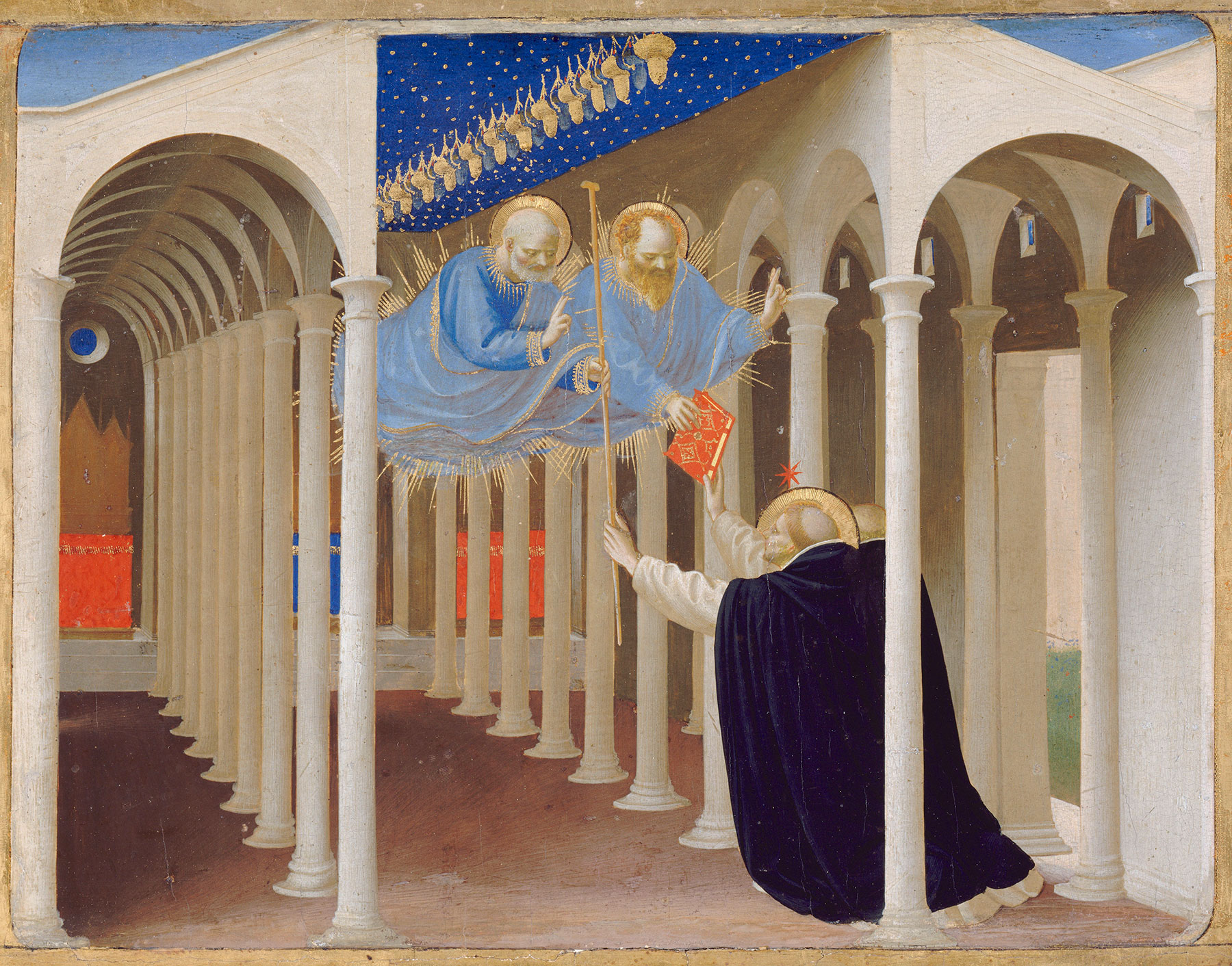
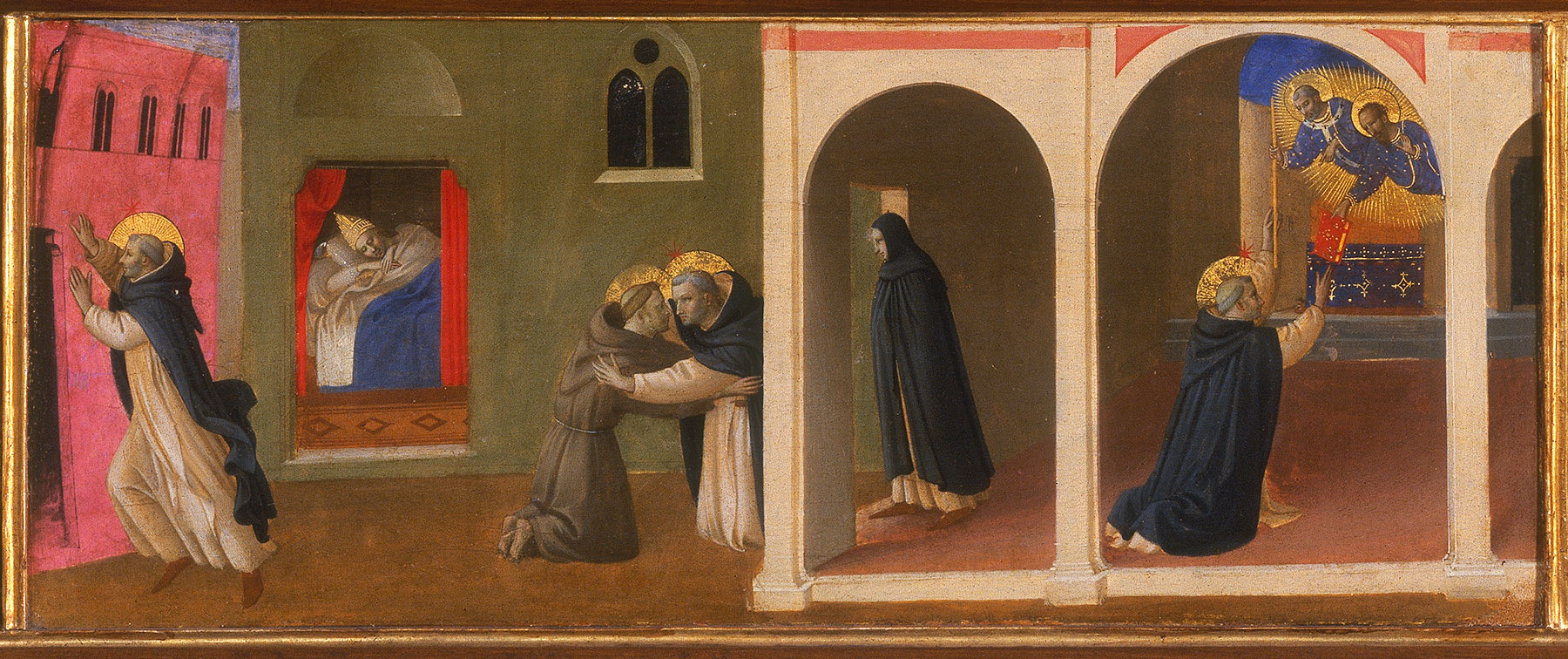
The composite structure of the support of the Yale panel, with an added piece of wood lap-joined and nailed on to extend it at the left, implies that it occupied the leftmost position in its complete predella. Such a conclusion is also supported by comparison of its painted subjects to the predellas in Paris and Cortona, where the same scenes appear at the extreme left, first in narrative sequence. Remnants of a gilt margin at the left of the painted field in the Yale panel might, therefore, have bordered the framing pilaster base at this end of the altarpiece, rather than demonstrating that gilded strips divided the scenes of the predella from each other. The absence of such a margin at the right edge could either confirm that the successive scenes of this predella were not divided by gilt borders or imply that the Yale panel has been cropped short of such a border at the right. If the latter were true, it is possible that as much as five centimeters were cropped at the right edge, restoring which would result in the doorway being centered within the facade of Saint Peter’s Basilica.
In both the Paris and Cortona predellas, the scene following the vision of Saint Dominic recounts the miracle of Saint Dominic raising Napoleone Orsini, nephew of Cardinal Stefano Orsini, who had died when his horse fell into a ditch while he was riding. If this scene occurred in the predella of which the Yale panel formed part, it is not known to survive.4 A counterpart to the scene following it in both the Paris and Cortona predellas (figs. 4–5), the Disputation of Saint Dominic and the Miracle of the Book, does survive. The same size (34.3 × 46.4 cm) as the Yale panel, or as the Yale panel may be presumed to have been if it has been cropped, closely related to it in style and, like it, heavily damaged (although in this case extensively restored), it is certainly part of the same predella. Published in the 2005 exhibition catalogue from an old photograph and as of unknown location, the panel itself was rediscovered in a private collection and included in the exhibition after the catalogue was printed (fig. 6). In this scene, Dominic, at the far left, gives to a Catharist heretic in Montréal, France, a book in which he had written out his arguments against the sect’s false beliefs. The heretic brought the book to his fellows, who urged him to throw it into the fire: if it burned, their doctrines would be proven true; if it did not, they would follow those of the Church as preached by Dominic. Three times they threw the book into the fire, and three times it rose unharmed from the flames, to the astonishment and consternation of the six men gathered around it.
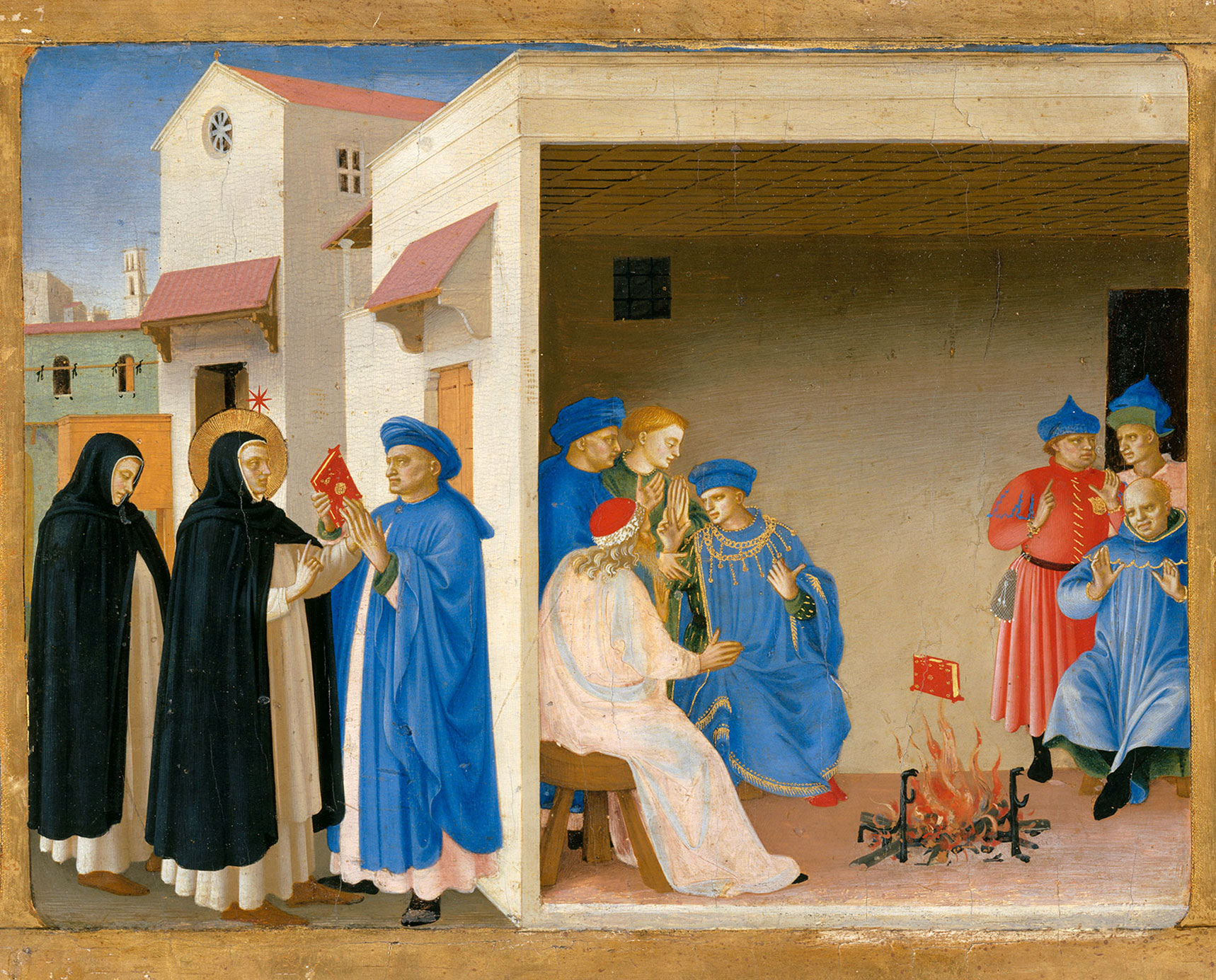
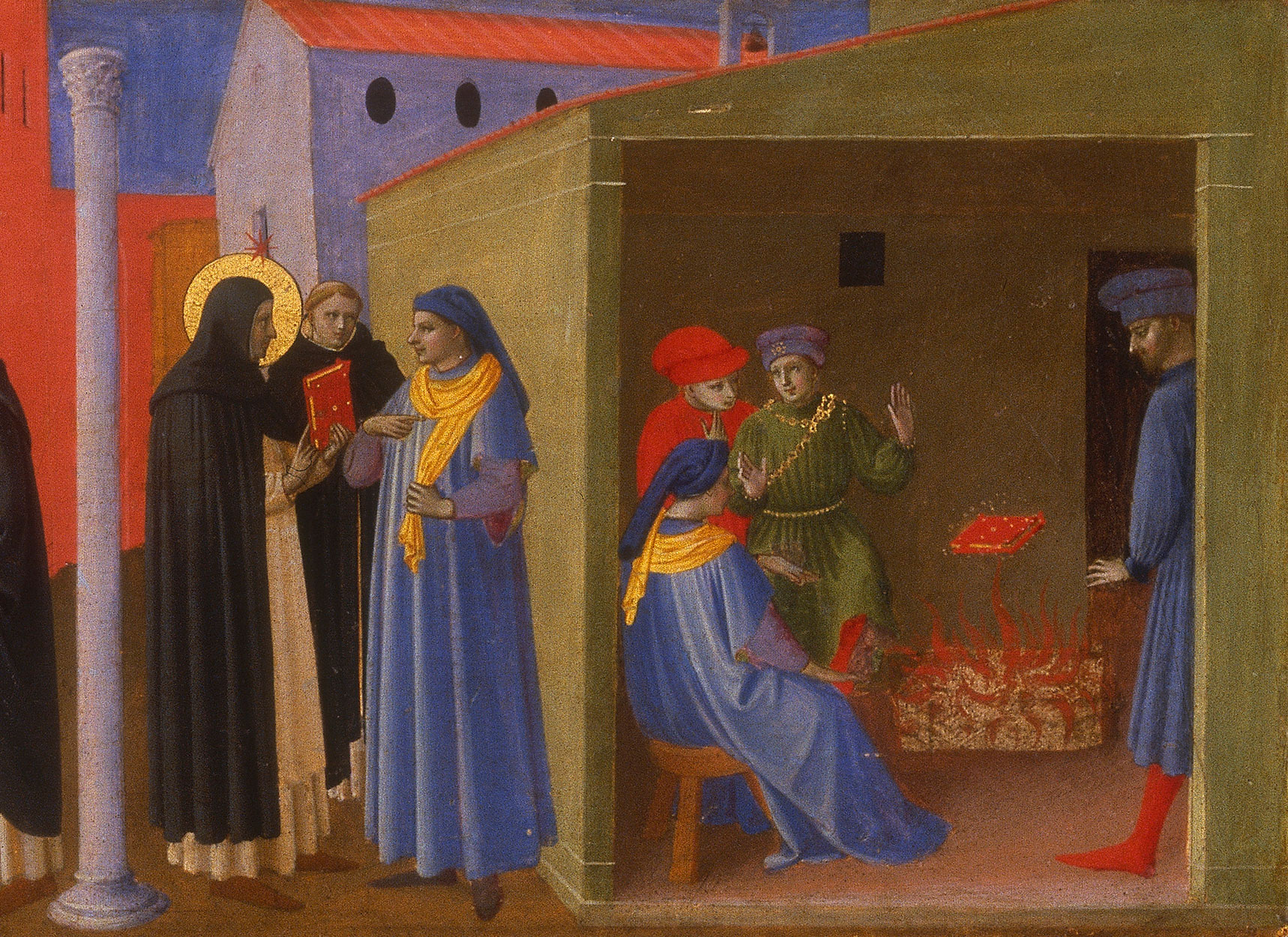
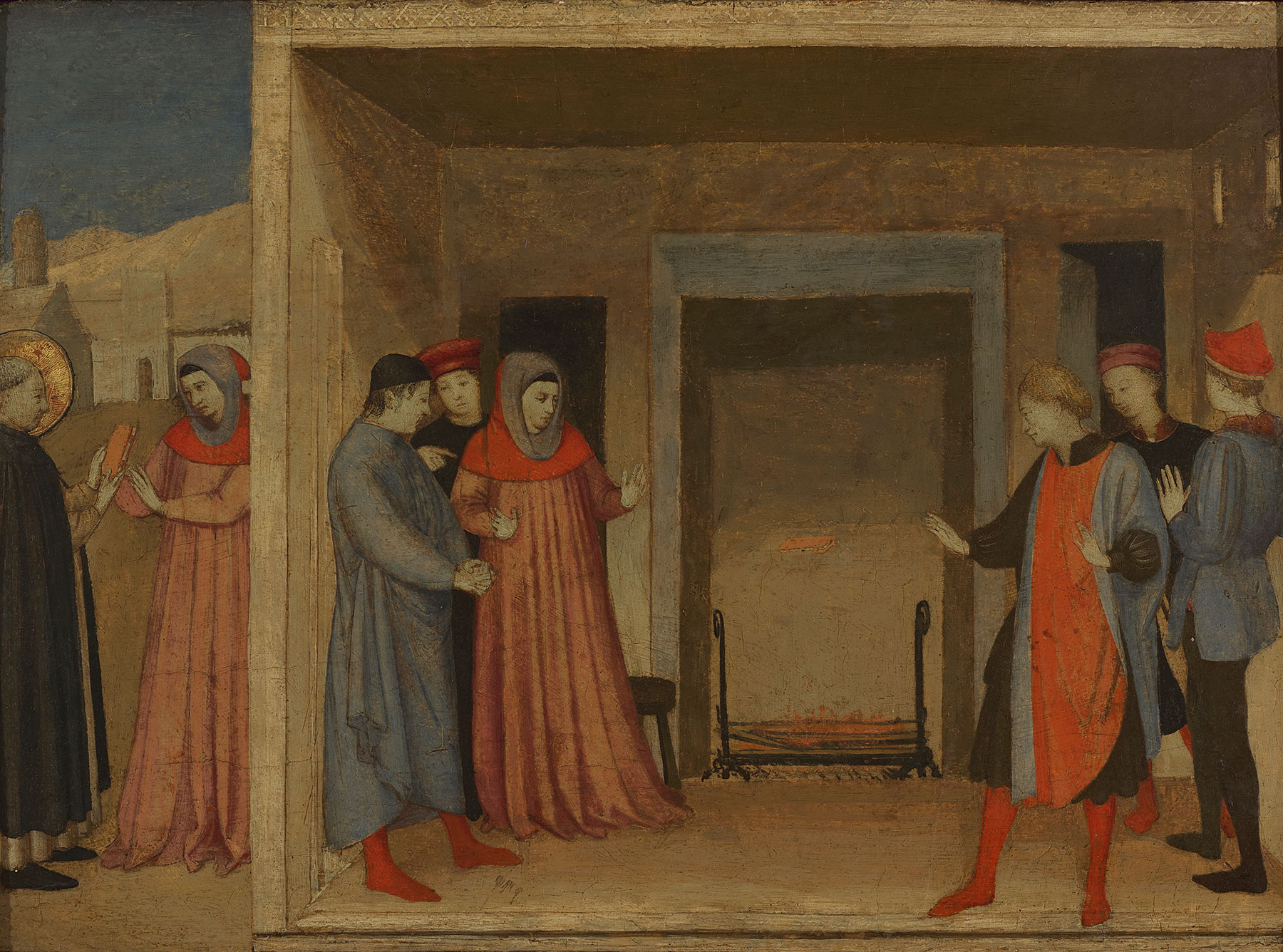
Following the Miracle of the Book in both the Louvre and Cortona predellas is a scene of Saint Dominic and his companions fed by angels in the convent of San Sisto Vecchio in Rome (figs. 7–8). When not enough bread could be found to feed the forty friars in the community, Dominic enjoined the brothers to divide what there was among themselves. As they prepared to dine on these tiny morsels, two angels appeared with aprons full of bread, which they placed on the table before Dominic. A version of this scene (fig. 9)—measuring 35 by 47.7 centimeters and clearly belonging to the Yale predella—is preserved in the Staatsgalerie Stuttgart, Germany. Although even more severely damaged than the Yale panel, it is at least as sophisticated in its narrative construction. The spare setting of the convent refectory contrasts markedly with the accumulation of gratuitous architectural detail in the Louvre predella and even more strikingly with the implausible outdoor setting employed in the Cortona predella. In the Stuttgart panel, the artist has focused on the human drama of the event and imparted a sense of divine or miraculous consequence by relying on light rather than line to define details and by imposing a crystalline, almost balletic symmetry on his composition. It is probable that when it was well preserved, few works from Angelico’s late career rivaled this one for the sophistication of its conception and execution.

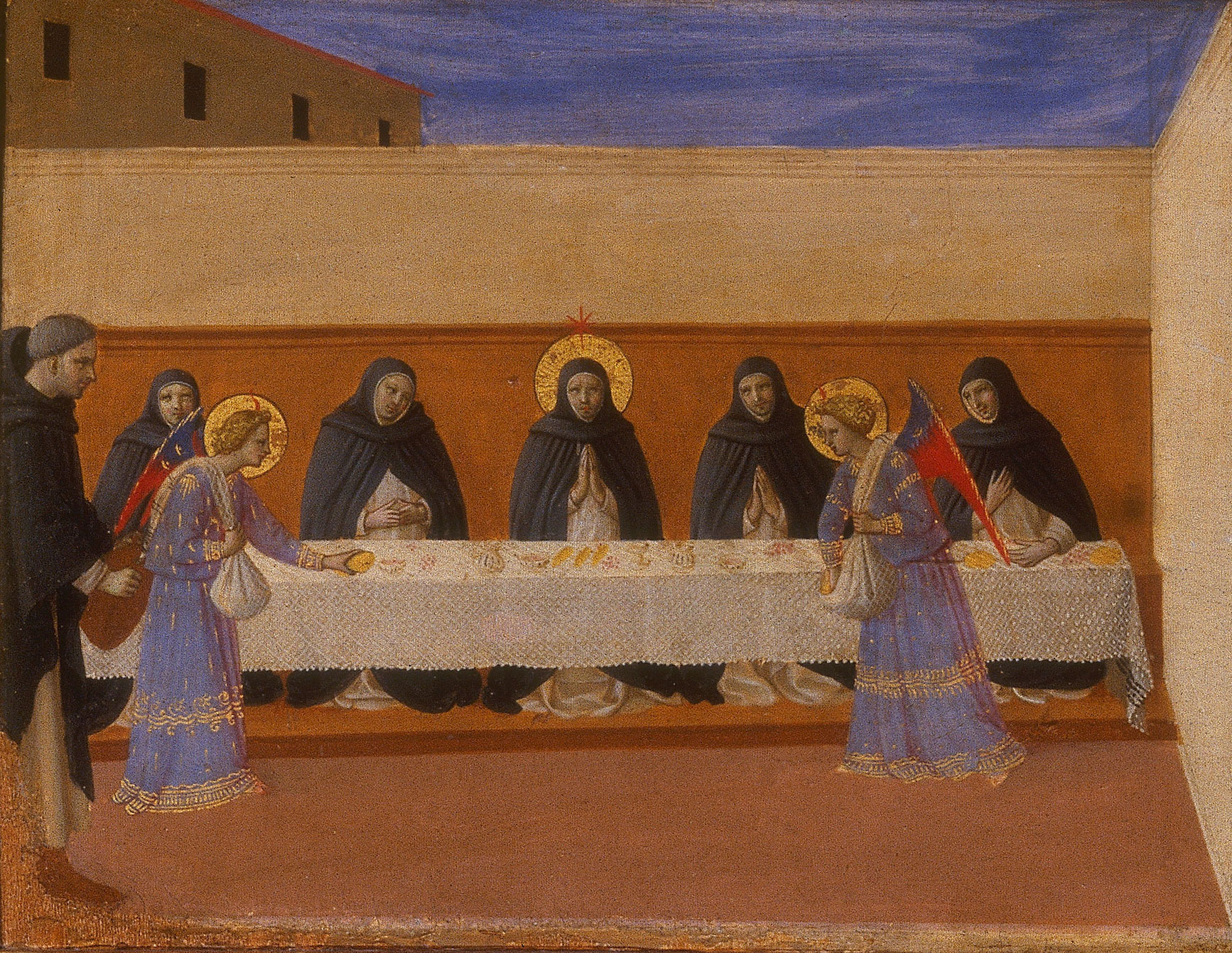
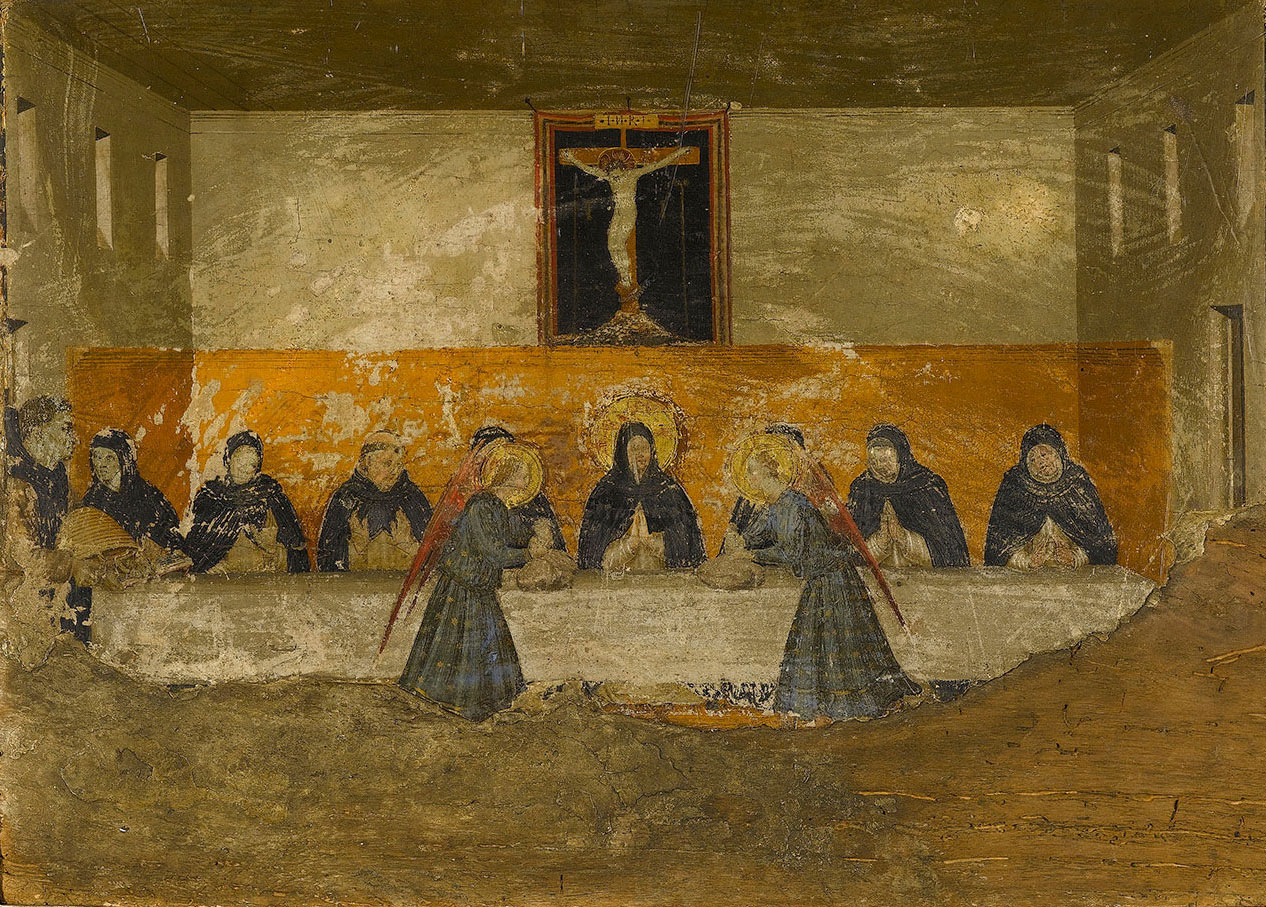
The Yale predella could have concluded with a now-missing scene of the Death of Saint Dominic, as do the predellas in Paris and Cortona, or the Stuttgart Miracle of the Bread could have been its final scene, as might be suggested by the fragment of a gilt border preserved along its right edge. It was suggested in the 2005 New York exhibition that the center of the predella might have been occupied by a Passion scene, echoing the presence of a Man of Sorrows at the center of the Louvre predella, and it was proposed to identify that scene with a Crucifixion and nine saints (fig. 10) in the Metropolitan Museum of Art. This identification was rejected subsequently by Gerardo de Simone.5 Admittedly problematic, though perhaps not for the reasons adduced by de Simone, including the duplication of subject with a wall hanging portrayed in the background of the Stuttgart panel, inclusion of the Met Crucifixion in this reconstruction is not impossible but cannot be regarded as straightforward. If it did accompany the Saint Dominic panels, the overall length of the predella would have been approximately 240 centimeters, a size equaled in Angelico’s entire career only by the predella to the high altarpiece for San Marco in Florence. If it did not, and the complete predella comprised either five scenes from the life of Saint Dominic or four scenes and a slightly smaller center panel (as at the Louvre), its total length would still have been close to 230 centimeters. Its monumental scale and its iconography, focused on the founder of the order, strongly suggest that it stood on the high altar of a major Dominican establishment. One proposal raised in the 2005 exhibition was that the predella could have been part of the altarpiece of the Annunciation that Giorgio Vasari claimed to have seen in Santa Maria sopra Minerva, in Rome, the convent at which Angelico passed his final years and in which he was buried in February 1455.6 Although no trace of such an altarpiece survives and no documentation has come to light proving that it might have been commissioned from Angelico, the proposal was accepted enthusiastically by de Simone. De Simone adduced as additional evidence of a Roman provenance the resemblance of the door moldings through which is seen the vision of Saint Dominic in the Yale panel to those designed by Bernardo Rossellino for Santo Stefano Rotondo in Rome in 1453. Further, assuming the graffito monogram scratched into the facade of Saint Peter’s in the Yale panel to be original and deliberate, he interpreted its conjoined N and P to signify Nicolaus Pontifex, for Nicholas V, Angelico’s patron, who was responsible for transferring the seat of papal authority from the Lateran to the Vatican. Accordingly, de Simone dated the predella between 1453 and 1454—which is completely plausible on stylistic grounds—and acknowledged it as one of Angelico’s last works, indeed, one of the few works surviving from the last years of the artist’s career. —LK
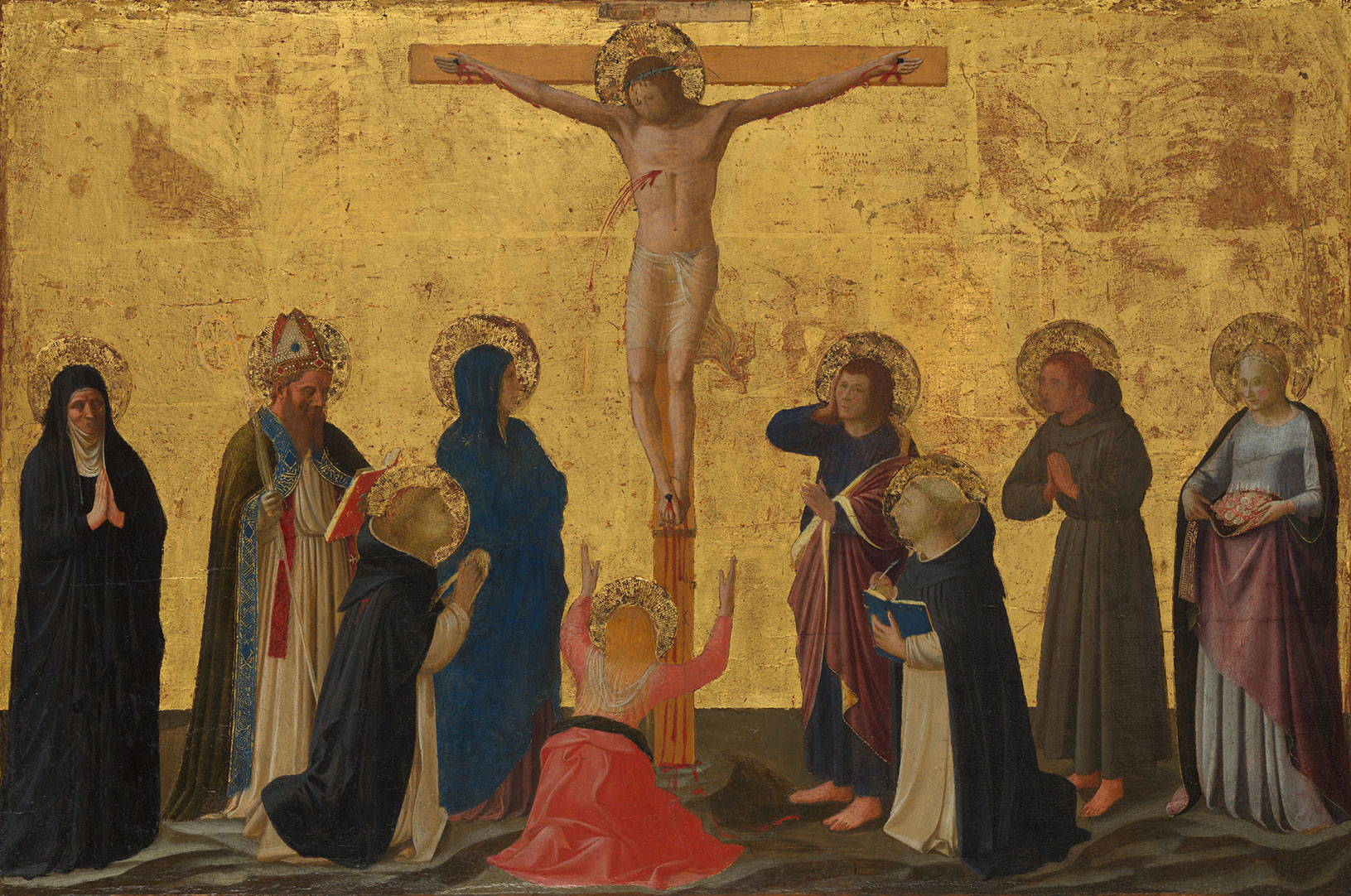
Published References
Seymour, Charles, Jr. Early Italian Paintings in the Yale University Art Gallery. New Haven: Yale University Art Gallery, 1970., 114–15, 312, no. 78; Pope-Hennessy, John. Fra Angelico. 2nd ed. London: Phaidon, 1974., 229, fig. 88; Laurence Kanter, in Kanter, Laurence, and Pia Palladino, eds. Fra Angelico. Exh. cat. New York: Metropolitan Museum of Art, 2005., 217–21; Gerardo de Simone, in Zuccari, Alessandro, Giovanni Morello, and Gerardo de Simone, eds. Beato Angelico: L’Alba del rinascimento. Milan: Skira, 2009., 230–31; de Simone, Gerardo. Il Beato Angelico a Roma, 1445–1455: Rinascita delle arti e Umanesimo cristiano nell’Urbe di Niccolò V e Leon Battista Alberti. Florence: Leo S. Olschki, 2017., 206–7
Notes
-
Seymour, Charles, Jr. Early Italian Paintings in the Yale University Art Gallery. New Haven: Yale University Art Gallery, 1970., 114–15, no. 78. ↩︎
-
Pope-Hennessy, John. Fra Angelico. 2nd ed. London: Phaidon, 1974., 229. ↩︎
-
Laurence Kanter, in Kanter, Laurence, and Pia Palladino, eds. Fra Angelico. Exh. cat. New York: Metropolitan Museum of Art, 2005., 217–21. ↩︎
-
See Laurence Kanter, in Kanter, Laurence, and Pia Palladino, eds. Fra Angelico. Exh. cat. New York: Metropolitan Museum of Art, 2005., 221n3: a fragmentary copy, measuring 23.3 by 18.1 centimeters, of the right third of the scene of the Raising of Napoleone Orsini from the Cortona predella was exhibited in Stuttgart in 1950. See Frühe italienische Tafelmalerei. Stuttgart: W. Kohlhammer, 1950., 50, fig. 80. The subsequent history of this panel is unrecorded, its present whereabouts are unknown, and from the photograph in the Stuttgart catalogue it is not possible to judge either its condition or its authorship. ↩︎
-
Gerardo de Simone, in Zuccari, Alessandro, Giovanni Morello, and Gerardo de Simone, eds. Beato Angelico: L’Alba del rinascimento. Milan: Skira, 2009., 230–31; and de Simone, Gerardo. Il Beato Angelico a Roma, 1445–1455: Rinascita delle arti e Umanesimo cristiano nell’Urbe di Niccolò V e Leon Battista Alberti. Florence: Leo S. Olschki, 2017., 206–7. ↩︎
-
Vasari, Giorgio. Le vite de’ più eccellenti pittori, scultori ed architettori. With new annotations and comments by Gaetano Milanesi. 9 vols. Florence: G. C. Sansoni, 1878–85., 2:516. ↩︎